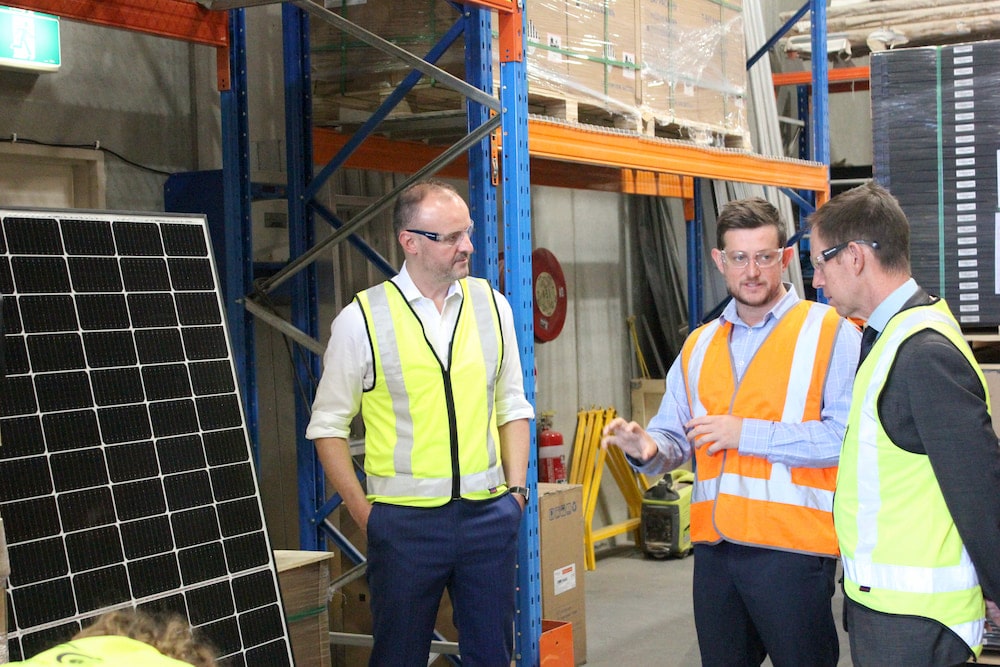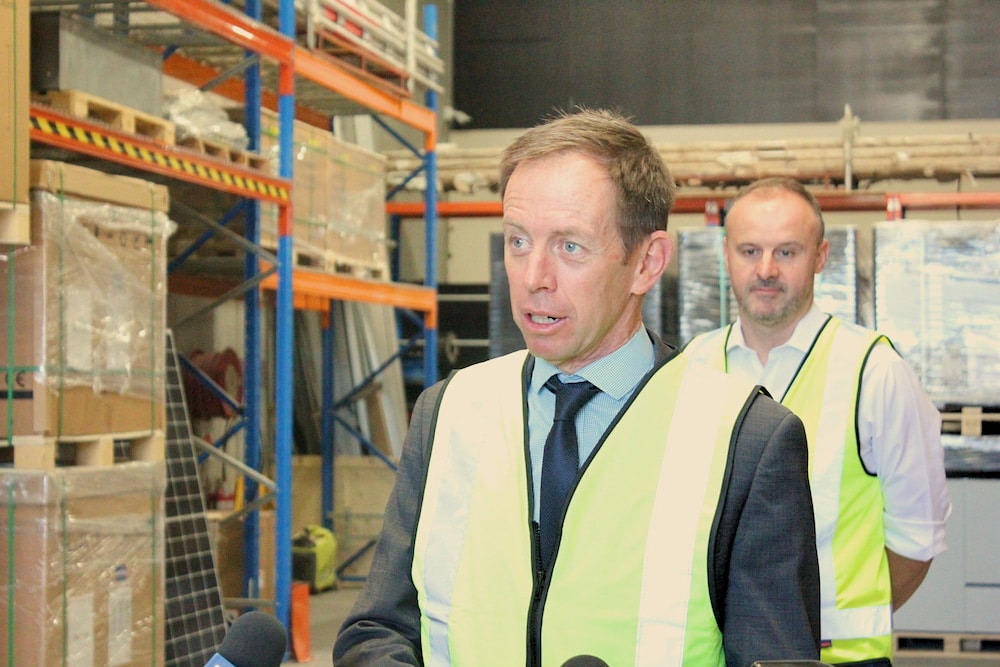More Canberra households will be able to install solar panels on their rooves and household battery storage, switch from gas to more energy-efficient appliances, and get interest-free loans for zero emission vehicles, ACT Chief Minister Andrew Barr announced this week.
These initiatives are part of the ACT Government’s plan to make Canberra a zero emissions city by 2045 – as Labor and the Greens promised at the last election.
Speaking at the SolarHub warehouse, Mitchell, yesterday morning (Thursday 21 January), Mr Barr and Shane Rattenbury, Minister for Water, Energy and Emissions Reduction, announced the government would invest $307 million over the next five years to deliver their climate agenda, beginning with this year’s Budget.
“Canberrans have made it very clear that they expect the government to take the lead on climate action,” Mr Rattenbury said. “The initiatives are designed to help Canberrans make the transition away from the fossil fuel past to the clean energy future.”
Last year, the ACT became the first jurisdiction outside Europe with a population of more than 100,000 to achieve 100% renewable energy; at the same time, it reduced its greenhouse gas emissions by 45% on 1990 levels.
The government intends to further reduce emissions by 50 to 60% by 2045, and to zero by 2045. Emissions from transport and burning fossil fuel gas remain the Territory’s two biggest sources of greenhouse gas, Mr Rattenbury said; the initiatives will help Canberrans to adopt environmentally friendly power sources.
The biggest obstacle to most ACT households transitioning to clean technology was the upfront financial cost, Mr Barr said. The government will establish a $150 million interest-free loan program, the Sustainable Household Scheme, so that middle-income Canberrans can borrow up to $15,000 to install rooftop solar panels, household battery storage, zero emission vehicles, and efficient electric appliances that are cheaper to run and better for the environment. This was an election promise last year.
Households should be able to register their interest in April. Although a small number of loans will be issued this year, Mr Barr said the vast bulk of the scheme would be undertaken over the following three years.
A third of the ACT’s population could take part; Mr Barr expects a minimum of 10,000 applicants, and possibly as many as 60,000.
Ben Masters, chief executive of solar equipment supplier SolarHub, welcomed the government’s investment in the industry.
“It’s great to see the government support all areas of this market. They’re obviously very ambitious with their respects to renewable energy. I think this money will open the door up for people who weren’t able to purchase [equipment] previously – people perhaps on slightly lower incomes who didn’t have $10,000 lying around to invest in a solar and battery system.”
A 6.6 kilowatt system varied from $6,000 at entry level to $10,000 for a premium system. A premium system would degrade more slowly, Mr Masters explained, lasting up to 25 years. He speculated that some people may invest in a premium system, since the interest-free loan meant they could now afford it. Repayments over the life of the loan would be less than the savings they would make by installing the system. “That’s a cash-positive investment.”

Electric vehicle revolution
The government was also aiming for “an electric vehicle revolution” over the next decade, Mr Rattenbury said.
Besides loans for vehicles, from May, ACT residents will have two years of free registration from the time they purchase a new zero-emission vehicle, while the government will set up a network of 50 public charging stations for electric vehicles.
“We need to move to electric vehicles and zero-emission vehicles as quickly as we can,” Mr Rattenbury said.
More vehicles are becoming available in Australia; car manufacturers like Volvo are phasing out the internal combustion engine; and electric car batteries with five-minute charging times will soon reach the market. Electric vehicles are also cheaper to run than their petrol equivalents, Mr Rattenbury said.
Better housing for the disadvantaged is also on the cards. The government will spend $50 million to improve energy efficiency in public housing, rental properties, and for low-income owner-occupiers; this will also reduce energy bills for vulnerable households.
The Big Canberra Battery (promised at the last election) is intended to be Australia’s largest renewable battery storage system, storing at least 250 megawatts across the ACT. At a cost of $100 million over the next five years, this will be a distributed network of thousands of batteries from Neoen’s 50MW battery and Global Power Generation’s 10MW battery to smaller ones in schools, businesses and households.
“When the last of the old coal-fired power stations go out of service, we [will] have an energy network that can meet our future needs,” Mr Barr said.
Renewables, he explained, generate power intermittently; the ACT needs the battery storage to dispatch the power immediately. It can provide backup power in case the total energy grid overloads or demand peaks on a hot summer day. With more electric vehicles on the streets, Mr Barr said, the demand on the energy network will increase.
“We’re going to need to continually invest in renewable energy and in storage.”
Other ACT Government climate initiatives include helping community clubs become more energy efficient; compelling electricity retailers to provide customers with a reference bill for a typical consumer, and to notify customers of plans that would reduce the customer’s bills; preventing gas connections in new suburbs; and establishing a Co-ordinator General for Climate Action.
Over the next three decades, Mr Barr envisaged that the ACT would continue to be a national leader in adopting new, clean technology.
“We will have transitioned by mid-century to a zero emissions economy. We will have a range of new jobs and industries that we didn’t think we would see. That tends to be the nature of technological change. We will be in a much stronger position, and we will have done our part – together, I hope, with thousands of other cities and hundreds of other nations – in contributing to significant emissions reduction and addressing the long-term challenges of climate change.”
For more news:



